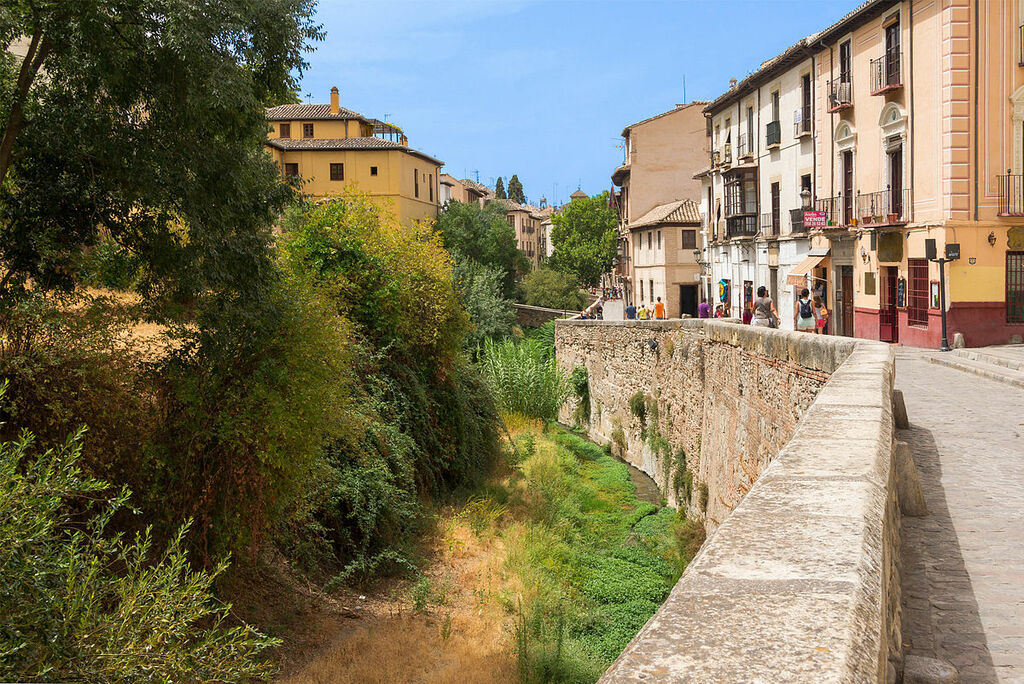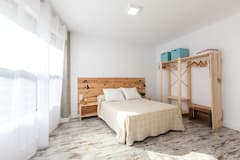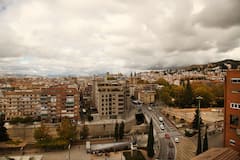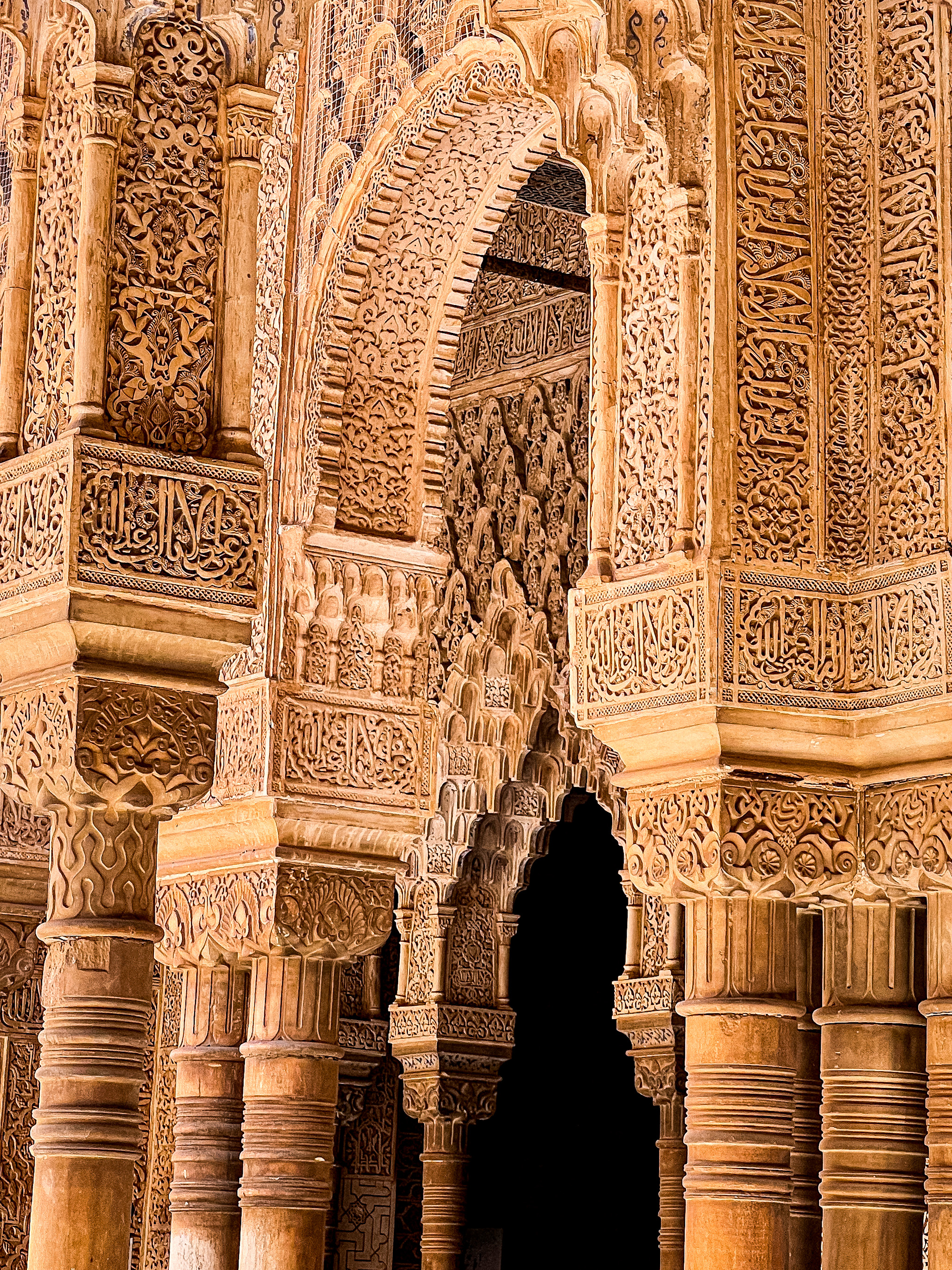Perched at the foot of Spain’s Sierra Nevada, Iberia’s highest mountain range, is Granada. A town landscaped with crags, ravines, and terraced fields, Granada is where the the steep slopes of the Sierra Nevada meet the plains. One of the most celebrated architectural highlights of the region is the ancient royal citadel of the Alhambra, which attracts many thousands of tourists to Granada each year. Magnificent architecture, energetic dance performances, gaudy fiestas, and religious processions, you’ll find an amusing combination of things to do here. Follow this list we’ve put together and experience the best of the city like a local. Here are the best non-touristy things to do in Granada, Spain.
Tip from tour guide
Granada has an interesting past, which includes the Napoleonic invasion, and you can witness them even today at some of the places in the city. Head to Camino de los Franceses, also known as the French Way, which is one of the most interesting areas of Granada to get away from the city and breathe. The best time to visit here is during the sunny days of winter.
Another such place is The Granada City Wall, built during the Nasrid period, which offers a glimpse into historic times. Inside the wall, the restoration of Torrecillas stands out, blending past and present through open spaces and light while preserving its identity. However, note that its value diminishes due to the neglected surrounding environment.
1. Have a walk to remember at Carrera del Darro

A walk down Granada’s Carrera del Darro is all things scenic. This narrow stretch is rife with crumbling bridges and beautiful facades all along. Strolling past, you’ll have the gentle River Darro on one side and 16th- and 17th-century buildings lining the path on the other side. In peak tourist season, it can get quite crowded here, but the allure remains intact. Walks at the dawn or dusk will only add to the experience. There are several restaurants and bars on the street, so fret not if the walk stimulates your appetite.
Carrera del Darro
Website: Carrera del Darro
Tip from tour guide
Carrera del Darro is the most beautiful street in Granada for many. The Darro River (Dauro, meaning "give gold") territorially divides Alhambra and Albaicín. It could even be considered a political division. In older times, Carrera del Darro was the neighborhood of Axares, and it was the area where the noble and the privileged lived during the Muslim era. Apart from this, the high-class street sometimes reminds Granadans of something else. Since the Darro River used to carry sewage, locals refer to it as "Darros," saying "it smells like Darro." This phrase is understood and widely used among Granadans.
2. Enjoy a picture-perfect sunset at Sacromonte Viewpoint (from USD 153.98)

You may be an avid photographer looking for a perfect shot or one who enjoys balmy wind slapping against your cheek–Sacromonte viewpoint will offer you best of both. Slightly removed from Granada’s main city center, this point offers some brilliant views of the region. A steep walk uphill the Gypsy quarter of Granada will take you to this highest point of the city. Once at the summit, you’ll find the challenging hike pays off with stunning 360-degree views of the Spanish countryside set against a picturesque landscape. Stay a bit longer and you’ll be able to catch the sun set over Albaicín. Enthusiastic travellers go a mile further and time their hikes in a way that they’re able to see the sun rise over the majestic Alhambra. Trust us, it’s definitely a sight!
Tip from tour guide
Did you know that Sacromonte is a famous camino (street) thanks to the zambras flamenco? Several old families here feel that flamenco is more than music. For them, it's an art. The nights in Sacromonte are filled with this art, especially at venues such as Venta del Gallo, Tarantos, La Rocio, and La Canastera. Travelers who visit Sacromonte can look towards the Alhambra, but when you turn around, you will find this surprise: the viewpoint of the Albaicín churches, which always remind me of Castilian cities, such as Toledo. If you're coming here, autumn is the most beautiful time to enjoy the views from Sacromonte.
Albayzin and Sacromonte Private Tour at Sunset
Duration: 2.5 hour
3. Call it a day watching the sun at Mirador de San Nicolás

If you thought Sacromonte viewpoint was stunning, Mirador de San Nicolás viewpoint is nothing less. Located higher up from the bars, white houses, and cobbled streets in the Albayzín neighbourhood, it offers an unmissable view of the Generalife Gardens and the Alhambra set against a backdrop of the magnificent Sierra Nevada ranges. Catching the sunset from here is a special delight. US president Bill Clinton was so taken in by the views from here that he went on to call it “the most beautiful sunset in the world”. It can be reached by foot or by a bus as well. However, please beware of bag-snatchers and pickpockets here.
Mirador de San Nicolás
Address: Calle Espaldas a San Nicolas s/n, 18009 Granada, Spain
Website: Mirador de San Nicolás
Tip from tour guide
Apart from Mirador de San Nicolás, the beautiful city of Granada has several other viewpoints from where you can admire its landscapes, ravines, and fields. One of them is El Zenete offering the best views of Christian Granada and The Church of Sacred Heart of Jesus.
Alternatively, you can visit Mirador de la Lona, whose name comes from La Casa de la Lona. This building was lost in the 20th century when it functioned as an Andalusian corrala. It was said that the sails of the ships of the Spanish Navy were built there, which is what it's named after.
Another popular spot is Mirador de la Churra, whose name derives from the Arabic Yûrra. It’s located on Almanzora Alta Street, and you can get there from Cuesta Gomérez.
You might be interested in these Airbnbs!
4. Go back in time at Casa de Zafra

Built in the 14th century as a modest Moorish house with a central courtyard and pool, Casa de Zafra is perhaps the best intact example of a residential dwelling from its time. There are excellent decorative wall paintings and carved ceilings you can appreciate here, thanks to several restorative efforts. If you’re an architecture or history buff, you’ll find a trip here simply amazing. There’s also a museum dedicated to take visitors through Spain’s past here. The visit won’t take you more than half an hour, so you must definitely take out that much time from your schedule and pay this place a visit.
Casa de Zafra
Address: Calle Portería de la Concepción, 8 18010 Granada
Website: Casa de Zafra
Opening hours: 10am - 5pm (daily)
Price: Free
Granada (Province) Tour Guide
Asier Garmendia
Hi! I’m Asier, welcome to Granada, the most wonderful and charming city in the world. I am a licensed tour guide, with a degree in Art History and specialized in the Alhambra. Let me show you as a local our traditions, food and heritage. The city of the Alhambra will not disappoint you !. Please don`t hesitate to contact me for private and flexible tours. My job is my passion!
Tours by Asier
5. Delight in good drinks and a side of food at La Sitarilla

La Sitarilla is a quintessentially Spanish bar, which you’ll find packed with locals regardless of what time you go there. Usually you expect getting a free drink with your meal at restaurants or bars, here it’s entirely the opposite. No matter which drink you order, it’ll always be accompanied by a complimentary dish of food. Ever heard of such a concept? Your drink could be a alcoholic, non-alcoholic, or even a fizzy beverage and the rule applies. The portions of the dishes are generous so order accordingly. The prices are unbelievably reasonable, too. The servers are helpful and friendly here, so don’t worry if you’re not very savvy in speaking Spanish. Most tourists are unaware of its existence so go there and give others plenty of reasons to be jealous!
La Sitarilla
Address: 7 San Miguel Alta Street 18002 Granada, Spain
Website: La Sitarilla
Opening hours: 10am - 12am (daily)
6. Head to Alcaicería Market, but not just for shopping

For a full-blown Arabian experience, head to the Alcaicería Market in Old Granada. Packed with quirky knickknacks that make for great souvenirs, you’ll find everything right from spices to fabrics in its narrow alleys. Cobbled streets and worn-out buildings that once made up a Moorish market have now transformed into a modern yet local market. Apart from shopping,which is its main calling point, you can also have a great time people watching, amplified by the historicity of the place. You can find yourself a good spot at one of the restaurants and just soak in the Arabian aesthetic and architecture all around. If you’re ambling about here, find your way to a courtyard that houses a fountain, perhaps a place where camels were once watered.
Alcaicería Market
Address: Calle Alcaicería, 1 Granada
Website: Alcaicería Market
Opening hours: 10am - 8pm (daily)
7. Spend a day with gypsies at the Sacromonte Gypsy caves

Meander slightly away from Granada’s main areas into Sacromonte and you’ll find a narrow path along the hillside ridge, leading your way into shacks and caves. Uniquely decorated with wood and metal artifacts, these are previously-abandoned spaces occupied by an eclectic mix of people now. While the original inhabitants were people of the Gitano or Romani descent, they have now been replaced by seasonal inhabitants, i.e. tourists, artists, etc. You can spend a few hours or even an entire night to enjoy the spirit of freedom that abounds the atmosphere here. The caves are enveloped in flora and fauna and have electricity. Although, shared bathrooms and lack of running of water might be a couple of things to keep in mind before venturing. Leave behind the city’s modern offerings behind and spend some time living with these gypsies for a non-touristy twist to your holiday.
Sacromonte Gypsy caves
Website: Sacromonte Gypsy caves
8. Have a night filled with dance, music, and a whole lot of energy at a flamenco show (from USD 33.0)
A trip to Spain can’t be considered complete if you haven’t attended at least one Flamenco performance. Having originated in the Granada region itself, you’ll find a great many spots in the city that you can hit up to witness this thrilling and energetic Spanish dance form. You can catch some superb shows at Sacromonte’s Gypsy caves that haven’t become commercialized and retain the original charm. There will be singing, dancing, tapping, dining, and wining, all in the course of one evening! Hispanic women sporting polka dot dresses and flaunting nuanced emotions as well as moves–ooof, we’re already in love!
Granada Flamenco Nighttime Show and Tapas at Cave Restaurant
Duration: 1 hour
9. Rid yourself of toxins with a relaxing hammam bath experience (from USD 86.0)
Introduced to Spain by the Andalucían Moors, hammams are a traditional Arabian equivalent of modern-day saunas and spas. Much like their contemporary counterparts, hammams offer services like bathing, steaming, and massage to alleviate stress. So give your body some tender love and care and book yourself an appointment at one of the many hammams in Granada. Several new services like aromatherapy and specialised massages have now been introduced by hammams in the town to make it a wholly pleasurable experience for their customers. This will definitely make for a perfect end to a tiring day or an exhausting trip.
Hammam Al Andalus Arabian Baths Experience in Granada
Duration: 1 hour 30 minutes
10. Visit a secret oasis in the middle of the city

Rising from a dark past when this spot housed a palace, dungeons, and a place of worship, the stunning gardens of Carmen de los Martires now lie here. Strewn with grottos, fountains, magnolias, palm trees, and walking paths, this place is an ideal non-touristy thing to do after a long day of activities for tourists. If Arabian hammams aren’t your thing, head here. The garden is styled with a typically French-English aesthetic–French Baroque architectural elements like the fountain and English-style garden setting–complementing an overall atmosphere of serenity and tranquility that exudes from every aspect here. There’s even a small lake with a lovely castle folly within its premises. Feed the ducks loitering around freely here or just sit and marvel at the greenery.
Carmen de los Martires
Address: Carmen de los Martires, Paseo de los Martires, Granada, Andalucia, Spain
Website: Carmen de los Martires
Opening hours: Varies (check website)
Price: Free
Tip from tour guide
Videos:
This was also known as the Prisoner's Corral. Originally it was an area of dungeons and silos and was named after the Christians who died in these prisons. Here, you’ll find the tree that inspired San Juan de la Cruz and the Acequia Real (royal irrigation canal). The main highlight of this garden is the embellishment that was added by its owner, Merrsmans, in the late 19th century. This place is a fantasy of picturesque Muslim and French gardens with romantic touches and Art Nouveau fountains. In terms of size, this is one of the largest in Granada, and you can also enjoy fantastic views from here. Moreover, the concept of using the garden for ornamental and practical purposes is a characteristic of this Andalusian Granada. Apart from this, one of the most important mystics in the history of the city came to meditate in this area.
Another must-watch here is the beautiful nymph cave. In Roman times, these natural caves were decorated in honor of the nymphs that inhabited them and were used as the sources of irrigation in garden.
A destination straight out of a story book
The setting of the city is such that it feels like the Middle Eastern folktale, “One Thousand and One Nights” coming to life. Relics of a warring past and notes of a thriving present make Granada a town like none other. Among Andalucía’s main cities, Granada is a humbling repository of Spain’s historical symbols as well as identity. For your trip to this magical destination, these non-touristy things to do in Granada are sure to keep your interest piqued.
Tip from tour guide
Granada houses several jewels that enhance the beauty of the city. One of them is Palacio de los Cordovae. The current one is a reconstruction from the 20th century, albeit with the original materials preserved. It houses the city archive, and its roofs are impressive. You should know that many open-air concerts are held here, and the En Órbita ones are very cool. You will also see an out-of-place column on the corner, which will give you a clue as to where the palace was originally located.
Try Grenadine cuisine at Damasqueros
Contributed by Tour Guide, Asier Garmendia

Since the last decade, Chef Lola has been the inspiration for Grenadine cuisine. Heading the Andalucian-inspired restaurant, Damasqueros, she is one of the chefs who has fought to find Granada a place among the culinary elite. Her passion, hard work, and humility show her love for the city. The restaurant features menus that continually adapt, offering seasonal products and mixing haute cuisine with the raw materials of the earth and the moment. The best part, however, is that Lola’s food is honest, and you will feel at home whenever you visit.
Have an enriching cultural experience at Centro de Documentación Musical de Andalucía
Contributed by Tour Guide, Asier Garmendia

Culture enthusiasts visiting Granada should check out Centro de Documentación Musical de Andalucía in Albaicín. There are places in Granada that often go unnoticed but deserve to be explored for their uniqueness, and this center is one of them. Housed in a building that probably dates back to the end of the 16th century, the center has beautiful glazed ceramic plinths. It was restored in the ‘90s by recovering its true appearance of painted Venetian brick. It’s one of the few, or perhaps the only, examples of the late Renaissance architecture in Spain.
Take a refreshing walk along Cuesta de Gomérez
Contributed by Tour Guide, Asier Garmendia

This tree-lined avenue falls on my way back home from work, and I love the cool shade in these high temperatures. The groves of Gomérez are the lungs of the center of Granada. Its existence dates back to reforestation in the Christian times. You can find a variety of trees in the area, such as Almez (the most common tree in Islamic times), chestnut, elm, London plane, laurel, tilapia, maple, and fresh berries.
Surround yourself in the greenery of Carmen de la Victoria
Contributed by Tour Guide, Asier Garmendia
Did you know that Granada has several carmens (gardens)? You can visit Carmen de la Victoria, which can be seen as an example of what we understand as a typical carmen in the Albaicín. But, it’s not like Carmen de los Mártires. Do you know how these gardens came into existence? The depopulation of Granada after the War of the Alpujarras and subsequent repopulation generated these large properties of orchards at the beginning of self-sufficiency, which later evolved into diverse gardens. If you want to understand this better, I recommend the book “El Carmen de la Victoria” by José Titos. It dismantles myths and brings a real vision of the history of the Granada garden.
Get enchanted with Fundación Rodríguez-Acosta
Contributed by Tour Guide, Asier Garmendia
The Realejo-San Matias neighborhood has an architectural jewel loaded with symbology. It’s called Carmen Rodríguez Acosta, also known as Fundación Rodríguez-Acosta, which boasts elements of the Modern Movement. Interestingly, the design of this place was inspired by the painting, “Isle of the Dead.” Fundación Rodríguez-Acosta not only catches your attention but also enjoys more symbolism than Alhambra. Here, you’ll get to see the sources that play the duality of the masculine and the feminine while a voyeur watches the naked goddess. It all happens here, and hence it’s my favorite place in Granada after Alhambra.
Enjoy the sunset at Paseo Fuente de la Bicha
Contributed by Tour Guide, Asier Garmendia
The beautiful Paseo Fuente de la Bicha or La Bicha is a favorite route among Granadians. It’s at the foot of Cerro de la Culebra and was used for raising birds that fed the Royal House during the Nazarene era. This route had a connection with The Palacio de los Alixares itself and was also a water carrier route for some time. These days, you can view breathtaking sunsets from here.
Explore the historic neighborhood of Albaicín
Contributed by Tour Guide, Asier Garmendia
Albaicín always greets you with the whitewashed houses and cobbled streets that contrast the flowered balconies. You’ll find alleys where the jasmine in the gardens makes you turn your head, and you can appreciate the beauty of these places through the small open peepholes in the wooden doors. The lower part of the Albaicín was the neighborhood of the nobility in Muslim times, and you can still find some of them, such as Horno de Oro or Zafra.
One of the most interesting Moorish homes in Albaicín is Casa del Chapiz. It belonged to a new Christian, Lorenzo “el chapiz.” Here, you can appreciate the cultural and architectural change that the city underwent after the Moorish Rebellion and witness two worlds and cultures in the same place. The number one use of water for architecture is to mirror the simplicity of forms, which you can find in the small courtyard of the Arrayanes.
Another building that is lost in the middle of Albaicín is Casa Horno del Oro. It’s a small Moorish structure that represents the domestic architecture of the area in Muslim Granada, but has adapted. Its second-floor open ambulatory, which serves as a gallery, is typical of more Western architecture. Apart from this, Puerta de Fajalauza gave access to the upper Albaicín, and some episodes occurred in this area that changed the history of Granada. These include the recovery of the throne by Boabdil and the beginning of the Moorish uprising that followed the Alpujarras War.
Another interesting place here is Placeta del Cobertizo, in the lower Albayzín area, named after one of the most common structures of Islamic urban planning, the shed. They are covered walkways within public roads that are common in Albaicín, especially in the Alpujarras. Sometimes, it’s thought that the streets in Arab urban planning are labyrinthine and unplanned, while the Christian streets are the opposite. In reality, it has much more to do with Islamic law and the sense of private property and buying and selling. When it comes to selling your property, the relatives, followed by the neighbors and the members of your guild, get the opportunity to buy first. Separate Albaicín houses remained, which were owned by a single family who built these sheds to connect them without having to go out onto the public road. As a result, we have the present-day Albaicín: winding streets due to moving facades, closed squares, dead-end alleys, and covered passageways, giving rise to beautiful and private squares.
Another popular place here is Plaza Larga, located in the heart of the Albaicín. It has emblematic establishments such as Casa Pasteles (1928). Its original name, La Estrella, was changed because the people of Granada always said, “Where are the pasties?” You can also see Bab-al-Ziyada Ensanche Gate, which connects Albayzín and Alcazaba Vieja. This gate is commonly called the “door of the weights” since tricked weights were hung above it, which belonged to swindler merchants who wanted to deceive the customer when they weighed the product.
Admire street murals through a discreet peephole
Contributed by Tour Guide, Asier Garmendia
Did you know about the hidden facilities around Granada? Julio Anaya has hidden a mural version of “El embovedado” by López Mezquita. On a street in the Virgen neighborhood, an indiscreet peephole invites passersby to find this art. All you need to do is explore and be aware of your surroundings. If you like mindfulness, which the Sufists of Muslim Granada already discovered, put it into practice around the city. The here and now can lead you to find a museum on your street.
Spend a few moments at Paseo de los Tristes
Contributed by Tour Guide, Asier Garmendia
The real name of Paseo de los Tristes is Padre Manjón or Puerta de Guadix, because it provided access to the city of Granada in Muslim times. Its name, Tristes, was given because it was the route to the San José cemetery, and people gathered in the square to pay their last respects to the deceased before starting the slope. In those times, some women were professional mourners. They dressed in black and appeared pale and sorrowful, patiently awaiting to be hired. They usually joined small families who could feel lonely in the environment. What a curious and spiritual job to professionally accompany them to cry for their deceased.
Admire the illustrious sculpture at Avenida de la Constitución
Contributed by Tour Guide, Asier Garmendia
One of the famous streets of Granada is Avenida de la Constitución, which is still called by its previous name, Calvo Sotelo, by many. It’s located in the area of San Lázaro, which was the military camp of the Catholic Monarchs. In fact, during the excavations of a parking lot, the remains of what could have been the first bullring in the city were found. Now, the avenue is decorated with illustrious figures of the city. Here, we can also see San Juan De la Cruz, who is not only the best song by Los Planetas, at least for me, but also the most important mystical poet in our history along with Saint Teresa of Jesus, and who was earlier in Granada for several years.
Catch up on the history of Parroquia San Gregorio Bético
Contributed by Tour Guide, Asier Garmendia

Parroquia San Gregorio Bético has its origins in a 16th-century hermitage where it was ordered to be built by the Catholic Monarchs. It’s held in honor of two monks, who preached at the door of Alhambra’s mosque. They were martyred for it, tied to horses’ tails and dragged to the dungeons. But more interesting is its change of use throughout history. It was a church, as we have seen, but it also functioned as a prison, a wine warehouse, a coal warehouse, a dance hall, and a brothel.
It’s located in the heart of Granada, and many people pass by it, but you can visit it. Its cloistered congregation has a tradition of praying at the altar all day and all year long. In addition, the convent has a very curious history of different uses in the past.
Spend a moment to admire the beautiful landscapes of Vega de Granada
Contributed by Tour Guide, Asier Garmendia
Vega de Granada is a region that is made up of more than 40 municipalities. This plain was and is the lung of Granada, in addition to the city’s orchard in Muslim times. Despite modernization and changes, some parts of the region continue to rely on and preserve traditional agricultural techniques and practices. La Vega is unique, with a varied and diverse heritage, but it continues to disappear due to urban development.
Capture panoramic views of Granada from Mirador del Torreon
Contributed by Tour Guide, Asier Garmendia
Mirador del Torreon is not at all touristy, but this small brick gazebo in the shape of a minaret has survived the creation of the Cartuja University campus. It belonged to a Jesuit complex and was used as an observatory. This congregation has ancient roots in Granada until 1767. Its academic activity resumed in 1894. They mainly focused on the study of seismology and astronomy. They were elite astronomers, so much so that the craters on the moon were named after important Jesuit astronomers.
History
Get Trip101 in your inbox
Unsubscribe in one click. See our Privacy Policy for more information on how we use your data







































Create an account to